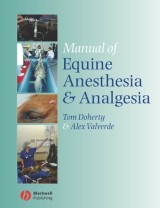Details

Manual of Equine Anesthesia and Analgesia
1. Aufl.
|
101,99 € |
|
| Verlag: | Wiley-Blackwell |
| Format: | |
| Veröffentl.: | 15.04.2008 |
| ISBN/EAN: | 9781405172752 |
| Sprache: | englisch |
| Anzahl Seiten: | 376 |
DRM-geschütztes eBook, Sie benötigen z.B. Adobe Digital Editions und eine Adobe ID zum Lesen.
Beschreibungen
In recent years, a number of important developments have been made in equine anaesthesia and analgesia. These include new methods of monitoring the patient, the availability of new drugs and the implementation of new procedures. This book not only covers all the traditional methods of anaesthesia and recent developments, but it provides students and practitioners with essential information on the scientific basis of anaesthesia, as well as giving handy tips on more practical aspects of anaesthesia, such as drug regimens for field anaesthesia. <ul> <li>Covers all the latest developments in equine anaesthesia whilst providing the reader with lots of practical information</li> <li>Includes detailed coverage of the sciences behind anaesthesia and the drugs used</li> <li>Easy-to-read format, with lots of bulleted lists and tabulated information</li> </ul>
Preface. <p>Acknowledgments.</p> <p>Contributors.</p> <p>List of abbreviations.</p> <p><b>Chapter 1 Preoperative Evaluation.</b></p> <p>The risk of equine anesthesia (<i>Tanya Duke</i>).</p> <p>Preoperative evaluation and patient preparation.</p> <p>Serum chemistry testing prior to anesthesia (<i>Nicholas Frank</i>).</p> <p><b>Chapter 2 The Cardiovascular System.</b></p> <p>Physiology of the cardiovascular system (<i>Tamara Grubb</i>).</p> <p>Evaluation of the cardiovascular system (<i>Rebecca Gompf</i>).</p> <p><b>Chapter 3 The Respiratory System.</b></p> <p>Evaluation of the respiratory system.</p> <p>Anatomy of the respiratory system (<i>Robert Reed</i>).</p> <p>Physiology of the respiratory system (<i>Carolyn Kerr</i>).</p> <p>Airway management.</p> <p>Temporary tracheostomy (<i>Frederik Pauwels</i>).</p> <p>Ventilation of the horse with recurrent airway obstruction (<i>Carolyn Kerr</i>).</p> <p><b>Chapter 4 The Renal System</b> (<i>Ben Buchanan</i>).</p> <p>Anesthesia and the renal system.</p> <p><b>Chapter 5 Neurophysiology and Neuroanesthesia</b> (<i>Tanya Duke</i>).</p> <p>Neuroanesthesia.</p> <p><b>Chapter 6 The Autonomic Nervous System</b> (<i>Christine Egger</i>).</p> <p><b>Chapter 7 Fluids, Electrolytes, and Acid-Base.</b></p> <p>Fluid therapy (<i>Craig Mosley</i>).</p> <p>Electrolytes (<i>Craig Mosley</i>).</p> <p>Acid-base physiology.</p> <p>Physicochemical approach (<i>Henry Stämpfli</i>).</p> <p><b>Chapter 8 Hemotherapy and Hemostasis.</b></p> <p>Hemostasis (<i>Casey J. LeBlanc</i>).</p> <p>Hemotherapy (<i>Hanna-Maaria Palos</i>).</p> <p><b>Chapter 9 The Stress Response</b> (<i>Deborah Gaon</i>).</p> <p><b>Chapter 10 Thermoregulation</b> (<i>Ralph C. Harvey</i>).</p> <p><b>Chapter 11 Pharmacology of Drugs Used in Equine Anesthesia.</b></p> <p>Definitions of anesthetic terms.</p> <p>Phenothiazines.</p> <p>Alpha2 adrenergic agents.</p> <p>Opioids.</p> <p>Benzodiazepines.</p> <p>Guaiphenesin.</p> <p>Tramadol.</p> <p>Barbiturates.</p> <p>Ketamine.</p> <p>Tiletamine and zolazepam (TZ).</p> <p>Propofol.</p> <p>Inhalational anesthetics.</p> <p>Nitrous oxide.</p> <p>Local anesthetics (<i>Leigh Lamont</i>).</p> <p>Intravenous lidocaine.</p> <p>Muscle relaxants (<i>Elizabeth A. Martinez</i>).</p> <p>Non-steroidal anti-inflammatory drugs (NSAIDs).</p> <p>Drugs used in endotoxemia.</p> <p><b>Chapter 12 The Anesthetic Machine.</b></p> <p><b>Chapter 13 Positioning the Anesthetized Horse</b> (<i>Hui Chu Lin</i>).</p> <p><b>Chapter 14 Monitoring the Anesthetized Horse.</b></p> <p>Monitoring the central nervous system (<i>Joanna C. Murrell</i>).</p> <p>Monitoring respiratory function (<i>Deborah V. Wilson</i>).</p> <p>Monitoring cardiovascular function.</p> <p>Anesthetic agent monitoring (<i>Deborah V. Wilson</i>).</p> <p>Monitoring neuromuscular blockade (<i>Elizabeth A. Martinez</i>).</p> <p><b>Chapter 15 Management of Sedation and Anesthesia.</b></p> <p>Standing sedation.</p> <p>General anesthesia techniques.</p> <p>Inhalational anesthesia.</p> <p>Total intravenous anesthesia (TIVA).</p> <p>Partial intravenous anesthesia (PIVA).</p> <p>Anesthesia of foals.</p> <p>Anesthesia of horses with intestinal emergencies (colic).</p> <p>Anesthesia of donkeys and mules.</p> <p>Anesthesia of the geriatric horse (<i>Lydia Donaldson</i>).</p> <p>Anesthesia and pregnancy (<i>Lydia Donaldson</i>).</p> <p>Remote capture of equids (<i>Nigel Caulkett</i>).</p> <p><b>Chapter 16 Anesthesia of the Limbs</b> (<i>Jim Schumacher</i> and <i>Fernando A. Castro</i>).</p> <p><b>Chapter 17 Epidural Analgesia and Anesthesia.</b></p> <p><b>Chapter 18 Anesthesia of the Head and Penis</b> (<i>Jim Schumacher</i>).</p> <p>Anesthesia of the head.</p> <p>Anesthesia of the penis and pudendal region.</p> <p><b>Chapter 19 Anesthesia of the Eye</b> (<i>Daniel S. Ward</i>).</p> <p><b>Chapter 20 Analgesia.</b></p> <p>Physiological basis of pain management (<i>Alex Livingston</i>).</p> <p>Recognition of pain (<i>Deborah V. Wilson</i>).</p> <p>Analgesia for acute pain.</p> <p><b>Chapter 21 Complications and Emergencies.</b></p> <p>Anaphylactic and anaphylactoid reactions.</p> <p>Intraoperative hypotension.</p> <p>Intraoperative hypertension.</p> <p>Hypoxemia and hypoxia (<i>Hanna-Maaria Palos</i>).</p> <p>Hypercapnia.</p> <p>Intra-arterial and perivascular injections.</p> <p>Cardiopulmonary resuscitation.</p> <p>Postoperative myopathy.</p> <p>Neuropathy.</p> <p>Hyperkalemic periodic paralysis (<i>Rachael E. Carpenter</i>).</p> <p>Equine malignant hyperthermia (<i>Rachael E. Carpenter</i>).</p> <p>Delayed awakening.</p> <p><b>Chapter 22 Assisted Recovery</b> (<i>Bernd Driessen</i>).</p> <p><b>Chapter 23 Euthanasia</b> (<i>Ron Jones</i>).</p> <p>Index.</p>
"This manual contains comprehensive information on relevant physiology and pharmacology as well as detailed instruction in the art and science of equine anaesthesia.<br /> It boasts the best chapters on regional anaesthesia in any text on equine anaesthesia." (<i>Equine Veterinary Education</i>, 2007) <p>"...this appears to be a very useful book for veterinary students, nurses and equine clinicians - whatever their area of interest." (<i>Vet Times</i>)</p>
<b>Thomas Dohertyis</b> Associate Professor of Anaesthesiology at the University of Tennessee, USA. He lectures in principles of surgery, pain management and critical care. <p><b>Alexander Valverdeis</b> Assistant Professor in Anaesthesiology at the University of Florida, USA.</p>
In recent years, a number of important developments have been made in equine anaesthesia and analgesia. These include new methods of monitoring the patient, the availability of new drugs and the implementation of new procedures. This book not only covers all the traditional methods of anaesthesia and recent developments, but it provides students and practitioners with essential information on the scientific basis of anaesthesia, as well as giving handy tips on more practical aspects of anaesthesia, such as drug regimens for field anaesthesia. <ul> <li>Covers all the latest developments in equine anaesthesia whilst providing the reader with lots of practical information</li> <li>Includes detailed coverage of the sciences behind anaesthesia and the drugs used</li> <li>Easy-to-read format, with lots of bulleted lists and tabulated information</li> </ul>
Diese Produkte könnten Sie auch interessieren:

Handbook of Applied Dog Behavior and Training, Procedures and Protocols

von: Steven R. Lindsay

131,99 €















